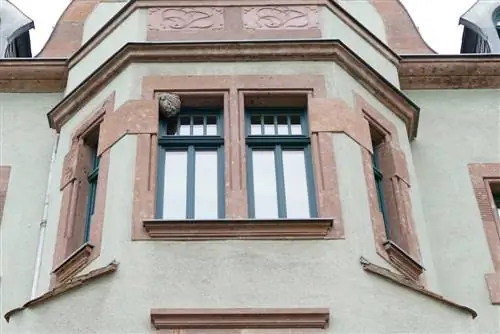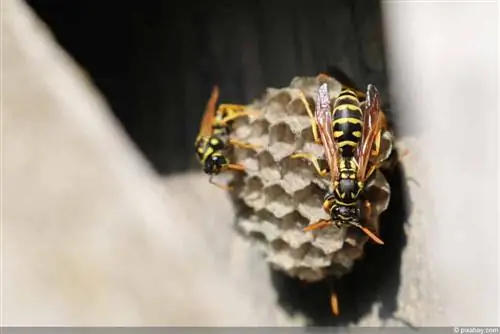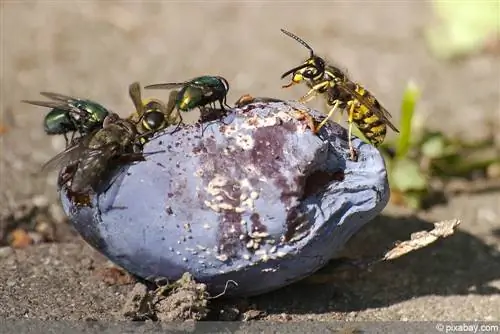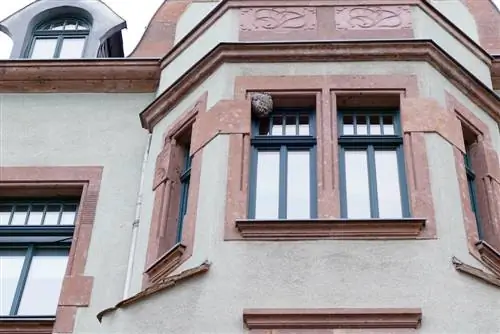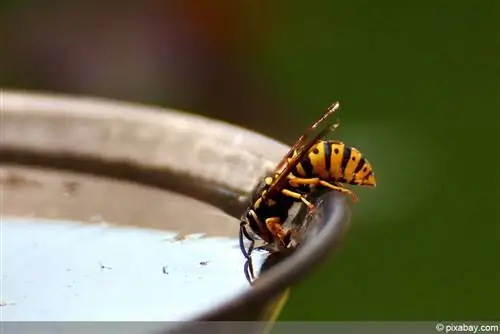- Author admin [email protected].
- Public 2023-12-17 03:39.
- Last modified 2025-01-24 12:45.
The time of the wasps comes in late summer. If local conditions allow the danger area of a wasp nest to be avoided and neither people nor pets come into contact with it, it does not necessarily have to be removed. The situation is different when the wasps pose a direct danger to humans and animals. At the height of the wasp population in summer, it is advisable to hire a professional to do this. If the nest is uninhabited, you can safely remove it yourself if you pay attention to a few things.
Wasp nest discovered, what to do?
Wasp nests are an integral part of the ecosystem and excellent pest controllers. In most cases you can live with them well. You usually only become aware of them in late summer, when the peak of the wasp year has been reached. The most common nests are those of the German wasp and the common wasp, which are active until October/November. Both the size of the nests and that of the wasp colony vary, which can contain up to 10,000 individuals.
All colonizing wasps, which include these two wasp species, will aggressively defend their nest within a radius of up to 6 m. Under certain circumstances, wasps can pose a he alth risk to humans and animals. Due to the fact that insects are protected, destroying and killing wasps is only permitted in exceptional cases.
First of all, you shouldn't panic and think calmly about what to do. If you try to remove a wasp's nest on your own, you risk more than just hefty fines. In addition, improper behavior only makes the animals aggressive. If allergy sufferers, small children or older people are at immediate risk from a colony of wasps, you should seek the help of a pest controller. If there is an acute danger, you can contact a wasp emergency service. There is no danger if the nest is no longer inhabited, which is usually the case in winter.
When a nest can be removed
Like all animals, wasps also fall under the Animal Protection Act, although some species, such as the hornet, are particularly protected because their populations are threatened. The German wasp and the common wasp also fall under general protection. If you decide to have the nest removed by a professional, there must be a serious reason that justifies the whole thing. This occurs if the nest poses an immediate danger to people.
A possible danger exists, for example, if people behave improperly when in contact with wasps, with certain species of wasps, an unfavorable location of the nest or at a certain time of year orStage of development of the wasp colony. In addition, allergy sufferers, small children and pets playing near a wasp nest can be reasons for removal.
Tip:
The contacts for this are exterminators, pest controllers and beekeepers or the responsible nature conservation authority.
Remove and relocate an inhabited nest yourself
It is generally not advisable to try to remove an inhabited nest yourself, because if the wasps feel threatened, they can attack their attacker at lightning speed. If you still want to dare, you should not do so without appropriate protective clothing, consisting of long-sleeved clothing, face or mouth protection and gloves. Full body protection, such as that offered by a beekeeper protective suit, would be ideal.
- Best time is early morning or evening
- Then it is cooler and the animals are hardly active anymore
- First you spray some water into the nest
- This makes the wasps temporarily unable to fly
- Wasp nests have one or more 1-2 cm entry holes
- They should be closed in the next step
- Then wrap the nest with a close-meshed net or curtain
- Then separate the nest at its junction
- Immediately place in a tightly sealable container
- Transport the nest in this box to its new location
- It should be at least four kilometers away from the old one
- Put the nest in the new location at approximately the same height
- Remove the curtain carefully and without hectic movements
- Recover entry holes and keep your distance
Remove nest preferably in winter
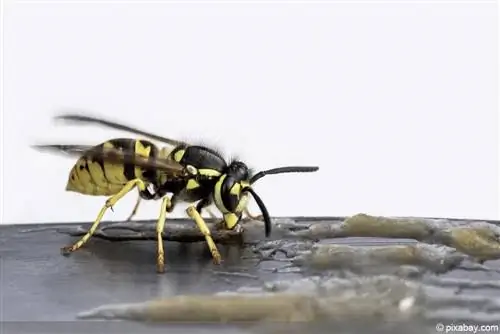
Winter is generally the best time to get rid of wasp nests, as they are usually empty by late autumn. In autumn the old queen dies and gradually the entire wasp colony dies. The young, fertilized queens overwinter in a frost-proof place and start looking for new nesting places from April/May. The old one remains uninhabited and can now be easily removed. Removing the nest should always be followed by thorough cleaning to prevent wasps from re-establishing themselves in the immediate vicinity of the old nest.
Use wasp foam or wasp spray
If the nest poses a specific danger and it is not possible to move it, it is advisable to use wasp foam or wasp spray with appropriate approval. Both drugs kill the animals relatively quickly. Here too, protective clothing must be worn, but above all a face mask. Wasp foam should only be used early in the morning or evening.
- Wasp foam can be used in cavities and in freely hanging nests
- Keep a safety distance of at least two meters
- In unfavorable locations, introduce the foam via a small tube
- Spray into entrance holes until escape routes are closed
- Foam kills the animals relatively quickly
- After a while it collapses
- Effect lasts long enough to reach incoming wasps
- Once the nest has calmed down, it can be removed
- One day later at the earliest
- Then clean the entire area
Due to its ingredients, wasp spray should only be used outdoors and only in extreme emergencies, as it kills the animals in a particularly painful way. In addition, some ingredients are toxic to water and the environment. It can be sprayed directly into the nest from a greater distance, so that even nests in unfavorable locations can be reached.
Tip:
Self-protection is particularly important when using wasp spray. Accordingly, you should definitely wear a breathing mask, safety glasses and gloves.
Why have it removed by a professional?
Help from a professional is particularly recommended in midsummer when a colony of wasps causes problems and people's he alth is seriously endangered. At the beginning of the wasp year, a wasp nest is still relatively small, but this quickly changes with rising temperatures, better food availability and increasing strength of the wasp colony. The most common problems occur in midsummer, when the colony is complete and the nest has reached its optimal size.
This is the case, among other things, if the nest is in an inconvenient, difficult to access and heavily frequented location. A specialist should be consulted now at the latest. He is able to close the wasp nest in a safer and more gentle way for wasps and residents, provided this is justified and permitted. The professional has the necessary knowledge and equipment to be able to approach the nest safely and eliminate it using modern control methods. As a rule, a layperson does not have all of this and may endanger not only his he alth, but also that of other people.
This is how the professional does it
The pest controller first finds out about the prevailing situation on site and gets an idea of the size of the wasp colony and their flight behavior. It also prefers to remove nests during the winter when they are uninhabited. If it becomes necessary to remove an inhabited nest in urgent cases, the pest controller will usually destroy it and kill the animals. To do this, he only uses the early morning hours or dusk, when the animals are hardly active.
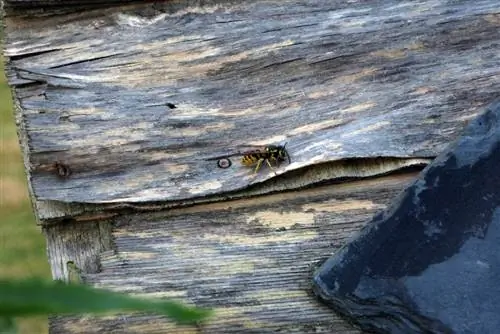
If the nests are still small, he covers them with a paper sack, separates the connection to the substrate and transports it away in a special box. If the population is already large, the professional first vacuums up all the workers flying around. They are fed into a box via a hose. He then removes the nest. If it does not pose a direct risk, the measures are limited to protecting residents. For example, he tries to fence in the wasp's nest, change the entry point or redirect the wasps' flight path.
Tip:
If you are interested in having the nest and wasps released as intact as possible and in another location, you should contact a beekeeper or the responsible nature conservation authority.
What you shouldn't do
In order to largely eliminate dangers from an inhabited nest, you should adhere to a few important rules of conduct. If necessary, you can come to terms with the animals until winter.
- Stay calm near the nest and do not make any hectic movements
- Do not stay in the direct flight path of the insects
- Avoid vibrations in the nest area
- Don't blow on wasps
- Never poke the nest with objects, wasps react aggressively to threats
- Always ensure a safe distance of at least 6 m from the nest
- For nests in and around the house, do not cover or close entry holes
- Never do anything yourself without protective clothing
Prevent nest building
Wasps prefer to build their nests under eaves, in attics, in roller shutter boxes or under window lintels. From April the queen starts looking for suitable shelter. If you notice a large, lonely wasp buzzing around the house repeatedly during this time, there is a high probability that it is a queen wasp who is in the process of building a nest.
To counteract this, you should close all hiding places where wasps can get into the house before the start of the wasp season. Structural damage should be avoided or repaired and possible nesting sites should be protected by fly screens. Since wood serves as a basic building material for wasps, it is advisable to deprive them of the necessary building material. Nests from the previous year should be removed as they increase the risk of repeated settlement in this area. A subsequent thorough cleaning of the old nest area is at least as important.

Since there are some plants that wasps don't like at all, it makes sense to plant or place them near possible nesting opportunities. These include, for example, geraniums, lavender, pelargoniums and pansies. On the other hand, plants that they find attractive, such as elderberry, privet, wild roses, dandelions or fruit trees, can help direct the wasps to certain areas and thus keep them away from the house. However, these plants alone cannot keep wasps away permanently or direct them to other places.
Conclusion
Wasps are essential for our ecosystem. They destroy countless pests and are also urgently needed to pollinate plants. Wasps are not inherently aggressive and only pose a danger when they feel threatened. Nests that pose a danger should always be removed by a professional. Otherwise, it makes sense to wait until winter. The nest is then empty and can be safely removed without professional help.

